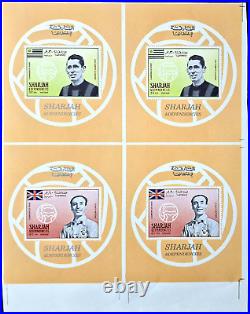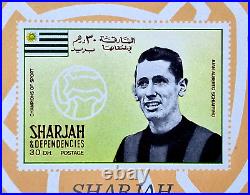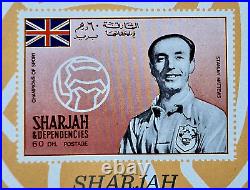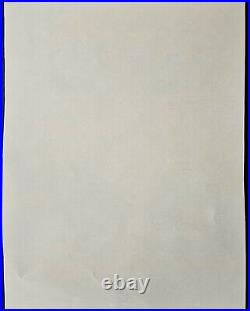United Arab Emirates 1968 imperf Sharjah UNCUTED PROOF Uruguay UK Soccer Stamps







UAE 1968 FOOTBALL URUGUAY & GREAT BRITAIN CHAMPS. 100% Original Old Stamps. United Arab Emirates 1968 imperf Sharjah UNCUTED PROOF Uruguay England Soccer. Stanley Matthews & Alberto Schiaffino Champions. Condition: Check the Picture, please. All items are absolutely guaranteed to be genuine and as described. With us, you can expect First-Class service and helpful consultation at no extra charge. PRODUCT INFORMATION COLLECTING IMPERFORATED PROOF STAMPS OF UNITED ARAB EMIRATES OVER THE YEARS IS NOT ONLY AN ACQUAINTANCE WITH HISTORY, BUT ALSO A PROFITABLE INVESTMENT. Rare Uncut Sheets of Football Stamps from Sharjah, UAE (1968): Why They Are a Must-Have for Collectors. In the world of philately, certain items stand out not just for their aesthetic appeal or historical significance, but also for their rarity and the stories they tell. The uncut sheets of football stamps from Sharjah, a member of the United Arab Emirates, issued in 1968, are one such example. These stamps, which feature champions from different countries, hold a unique place in both philatelic and football memorabilia collections. Their rarity, historical context, and cultural significance make them a must-have for serious collectors. The Historical Context: Sharjah and the 1968 Football Stamps. In the 1960s, Sharjah was one of the Trucial States, which later formed the UAE in 1971. During this period, Sharjah issued several stamp sets to promote its identity on the global stage. Among these, the 1968 football series is particularly noteworthy. This series was released to celebrate international football champions and coincided with the increasing global popularity of football as a sport. The 1968 football stamps from Sharjah feature a range of designs showcasing football teams and players who were champions in their respective countries. These stamps were not just an ode to the sport but also a way for Sharjah to connect with the global community, capitalizing on the universal appeal of football. The Rarity of Uncut Sheets. While individual stamps from this series are already considered valuable, the uncut sheets are a different level of rarity. Uncut sheets refer to sheets of stamps that have not been perforated or cut into individual stamps, making them a full sheet as they were printed. For the 1968 Sharjah football stamps, uncut sheets are particularly rare. Over time, many were either cut into individual stamps or lost, making surviving sheets incredibly scarce. Their rarity is further amplified by the fact that these stamps were issued in a relatively small number due to Sharjah’s status as a small emirate at the time. Why These Stamps Are Worth Collecting. Historical Significance : The 1968 football stamps capture a moment in time when football was solidifying its status as the world’s most popular sport. They also represent a significant period in the history of Sharjah, before the formation of the UAE. Collecting these stamps is like owning a piece of both football and Middle Eastern history. Sharjah’s decision to issue stamps featuring football champions from various countries underscores the emirate’s desire to engage with the broader world, making these stamps a symbol of cultural diplomacy. Investment Potential : Rare and well-preserved philatelic items have consistently appreciated in value over time. The uncut sheets of the 1968 Sharjah football stamps, due to their scarcity, are likely to continue this trend. As more collectors seek out rare football memorabilia, these uncut sheets are poised to become even more valuable. Aesthetic Appeal : The design of the 1968 football stamps is vibrant and detailed, capturing the spirit of the sport. The uncut sheets, in their full form, present these designs in a unique and visually striking way. For collectors who appreciate the artistry of stamps, these sheets are a true treasure. How to Acquire and Preserve These Rare Items. Given their rarity, finding uncut sheets of the 1968 Sharjah football stamps can be challenging. Serious collectors may need to search through specialized auctions, connect with fellow collectors, or work with dealers who have access to rare philatelic items. Once acquired, preserving these sheets is crucial. They should be kept in a controlled environment, away from direct sunlight, humidity, and potential damage. Using archival-quality materials for storage and display will help maintain their condition and value over time. The uncut sheets of football stamps from Sharjah, issued in 1968, are a unique and valuable addition to any philatelic or sports memorabilia collection. Their rarity, combined with their historical and cultural significance, makes them a highly sought-after item. As football continues to grow in popularity worldwide, and as the history of the UAE becomes more recognized globally, these stamps will only increase in importance and value. For collectors looking to invest in rare, historically significant items, these uncut sheets represent an opportunity that should not be missed. The Cold War emerged by 1947, as the Eastern Bloc, united under the Warsaw Pact in 1955, confronted the Western Bloc, united under NATO in 1949. On 5 March 1953, Stalin died and was quickly succeeded by Nikita Khrushchev, who in 1956 denounced Stalin and began the De-Stalinization of Soviet society through the Khrushchev Thaw. The Soviet Union took an early lead in the Space Race, with the first artificial satellite and the first human spaceflight. Khrushchev was removed from power by his colleagues in 1964 and was succeeded as head of state by Leonid Brezhnev. In the 1970s, there was a brief détente of relations with the United States, but tensions resumed with the Soviet-Afghan War in 1979. In the mid-1980s, the last Soviet leader, Mikhail Gorbachev, sought to reform and liberalize the economy through his policies of glasnost (government transparency) and perestroika (openness, restructuring). Under Gorbachev, the role of the Communist Party in governing the state was removed from the constitution, causing a surge of severe political instability to set in. The Cold War ended during his tenure, and in 1989, Soviet satellite states in Eastern Europe overthrew their respective communist governments. With the rise of strong nationalist and separatist movements inside the union republics, Gorbachev tried to avert a dissolution of the Soviet Union in the post-Cold War era. A March 1991 referendum, boycotted by some republics, resulted in a majority of participating citizens voting in favor of preserving the union as a renewed federation. Gorbachev’s power was greatly diminished after Russian President Boris Yeltsin played a high-profile role in facing down an abortive August 1991 coup d’état attempted by Communist Party hardliners. On 25 December 1991, Gorbachev resigned and the remaining twelve constituent republics emerged as independent post-Soviet states. The Russian Federation-formerly the Russian SFSR-assumed the Soviet Union’s rights and obligations and is recognized as the successor state of the Soviet Union. [11][12][13] In summing up the international ramifications of these events, Vladislav Zubok stated: The collapse of the Soviet empire was an event of epochal geopolitical, military, ideological and economic significance. Soviet Union topics History Index of Soviet Union-related articles Russian Revolution February October Russian Civil War Russian SFSR USSR creation treaty New Economic Policy Stalinism Great Purge Great Patriotic War (World War II) Cold War Khrushchev Thaw 1965 reform Stagnation Perestroika Glasnost Revolutions of 1989 Dissolution Nostalgia Post-Soviet states State Emblem of the Soviet Union. The Soviet Union officially recognized their independence on September 6, 1991, prior to its final dissolution three months later. [hide] v t e Flag of the Soviet Union. 2 Kazak ASSR was called Kirghiz ASSR until 1925. Vintage stamps and rare coins sale online! Type of capital investments, as investments in antiques is growing in popularity more and more each day. It’s quite a profitable and safe investment, as prices for antiques are steadily growing (on average 20% per year), which often exceeds the growth of stocks in the stock market. In addition, investment in antiques enriches not only materially bringing income but also spiritually, bringing esthetic pleasure. It is necessary to understand what things really have the potential to increase in value and which, on the contrary, are hopeless. The word “antique” has Latin roots and means “old”. The core value of antiques is in the fact that they are old. Age objects which are considered as antique, can start from 10-15 years, depending on the historical, physical and chemical characteristics of the object. Often, investment in antiques and collecting go hand in hand. Fortunately for new investors, in the environment of antiques consultants are available whose main task is to help the investor to separate the “wheat from the chaff” and to make competent investment. A lot of people begin with inexpensive paintings of young artists and a variety of interesting subjects. However, if you are not familiar with antiques, it is wiser to trust the various antique shops, exhibition and museum authority. If you want to do engage in such a profitable and exciting business, as investing in antiques, we will be happy to offer You assistance which will be provided by our experienced consultants who can help You see all the “pitfalls”, to make the right choices and get real pleasure from the trip to the mysterious and magical world of collection. Therefore, if you do not succeed in finding the item, let us know and we will find and order the product you are interested in. Features and further details. Definitely here you will find a lot of necessary and useful items which you are interested in. We will respond to you within 24-48 hours and do our best to help you out! If the description of the lot differs from its image, the image will have priority.
